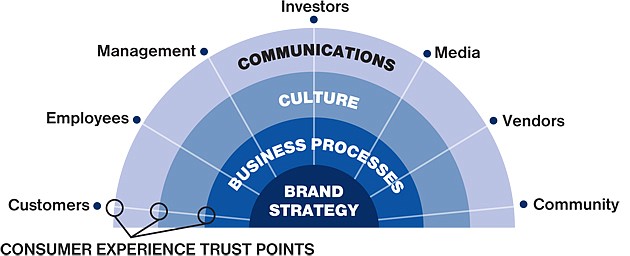- November 25, 2024
-
-
Loading

Loading

 The purpose of building a corporate or product brand is to gain and sustain a competitive advantage over your competitors. If a brand is differentiated and supported, it will achieve consistently better returns on your investment. Most times.
The purpose of building a corporate or product brand is to gain and sustain a competitive advantage over your competitors. If a brand is differentiated and supported, it will achieve consistently better returns on your investment. Most times.
However, even the best brand strategy can be derailed instantly if the customers have a bad interaction with the product or service supporting the brand. The opportunity for failure is astronomical when you consider the myriad things that can go wrong in an aspect of branding called “customer experience.”
The purchase decision is often described as the moment of truth for your brand. Creating an exceptional customer experience is more akin to preparing for a journey of trust with the journey's roadmap planned well in advance.
One way to evaluate the strength of your customer experience program is to try being a customer of your own brand. Does every interaction build purposefully toward making the purchase of your product or service seemingly effortless and pleasurable? What about service after the sale? Does your brand deliver on its promise? Honestly, would you become a repeat customer of your own brand?
The journey of the customer experience begins with your basic brand strategy. As the customer's journey progresses, there are many interactions with the brand strategy along the entire route. From the first advertising seen, to the website visit and comparison-shopping, to the sales person, to the sale itself, and of course interaction with the product that was purchased. Quantifying these experiences and analyzing the data will tell you if there are hidden potholes, detours, and anxiety-causing bumps that damage your brand along the journey.
Another way to think about your corporate brand is to think about it like a radio station. The brand is your beacon coming out of the corporate headquarters. Your beacon is sending out a signal like the radio station. The signal can be loud and clear, or it can be filled with static, depending on many considerations: the power of the signal, distance from the station, atmospheric condition, etc.
The radio station reaches varied audiences, including your customers, employees, investors, media, community leaders, etc. The signal of your corporate brand is broadcasting to all of these audiences, but the signal is transmitted through your business processes, culture and behavior of employees, and all communications—whether planned or unplanned.
At each of these intersections, or what we call the “customer experience trust points,” the signal has an opportunity to become distorted. Monitoring and tuning the signal to stay consistent is what it means to manage the customer experience.
The cruise-line industry provides a vivid example of the potential for misalignment of the customer trust points between the brand strategy and the delivery of the service. The promise of the business strategy is for a fun, carefree and relaxing voyage to exciting and exotic destinations. The business processes include strict safety rules for the sailing of the ships, food service and cleanliness. The culture is how well the employees on the ship are trained to adhere to the safety rules while still maintaining an atmosphere conducive to the business strategy.
Communication is everything from the advertising that captured the customer to sign up for a particular cruise, to the onboarding, to the announcement of bad news indicating a problem on the ship and how it will be handled, to disembarkation. Communicating both in good times and bad can help overcome problems and maintain customer loyalty even when a problem occurs.
Customer experience extends well beyond your customers. Other key audiences are diverse and influential. When building a brand, it is important to keep all key audiences in mind as if they are customers — with the goal of understanding how each audience will respond to your brand message. Aligning thought and action from your brand to each audience is the essence of managing customer experiences to drive value.
James R. Gregory is founder and CEO of CoreBrand, a global brand strategy, communications and design firm headquartered in New York, with offices in Los Angeles and Tampa. He helps clients develop strategies to improve their corporate brands and profitability. Contact him at
[email protected].